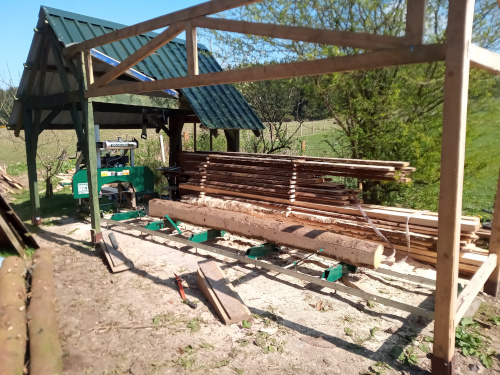By: Simon Brooke :: 14 May 2023

I'm currently sawing all the trees that blew down in my wood into timber, most of which will be used in buildings here on the farm. The sawmill I'm using is petrol driven. I'm trying to work out what the relative carbon cost of sawing it is, as opposed to leaving it to rot.
So, firstly, these are not trees I am felling. Only two standing trees have been felled, out of about 2,000 down; those two were actively endangering my house. Other than those two, all the trees were brought down in storms, mostly Storm Arwen. If left on the ground, they will rot and release most or all of their carbon over a relatively short period.
I am cutting the trees into logs with a chainsaw, and that also burns petrol (but not much), but I'm winching the logs out of the wood out by hand.
Sitka is roughly 49% carbon by dry weight. It has a specific gravity of 0.33 dry (ibid). My trees average about 200 mm diameter at breast height by about 20 metres tall, so the total volume of the trunk is about 0.2 cubic metres (which, envisioning that in terms I can understand, is one piece of timber 200 mm x 200 mm x 5,000 mm long, or five beams each 200 mm x 50 mm x 5,000 mm). But, in practice, only about 50% of that volume is usable, so what you're really getting out of each tree is the equivalent of five 100 mm x 50 mm x 5,000 mm pieces, which feels about right.
So if a tree trunk averages 0.2 cubic metres, its total embodied carbon content is about 33 kg. If it rots within five years, it emits about 7kg of carbon a year, or my whole wood (2000 trees down) emits 14 tons of carbon a year over the next five years. I'm ignoring what the remaining live trees sequester, because they're going to remain standing anyway so that makes no difference; I'm also stating the weight in carbon emitted, not the weight in carbon dioxide or methane, which would of course be substantially more.
In the past few days I've produced 49 good quality beams totalling 170 metres run and 1.5 cubic metres of timber, using five litres of petrol. Petrol contains about 0.63 kg of carbon per litre, so I've emitted 3.15 kg of carbon; but I've delayed the emission of 250 kg of carbon.
Delayed by how much? All of the timber I'm producing will go into structures, mostly people's homes. Homes have an average life expectancy of about sixty years. So it's the equivalent of, instead of taking five years to rot, taking sixty-five years to rot; so for every ton of timber I saw, instead of that timber emitting on average 32kg of carbon per year over five years, it's instead emitting on average 2.5 kg of carbon per year over sixty five years; and to achieve that I'm emitting 6.3 kg of carbon.
This feels to me, in terms of the climate crisis, quite reasonable economics.
Obviously the parts of the tree I don't turn into usable timber will still rot down (or be burned), but then they would have anyway; so, although that is significant, it doesn't affect the overall net saving.
« Please sir, we want more... | | On the protection of minorities »




